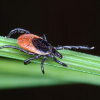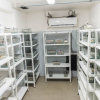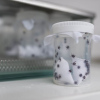Testing of anti-transmission agents on ticks
Technology description
| The name of the technology: | Testing of anti-transmission agents on ticks |
|---|---|
| Challenge: | Sufficient capacity of the tick breeding facility and a reliable laboratory transmission model are required for routine testing of vaccines and preparations to prevent Borrelia transmission. Such a model already exists in the USA, but due to the different biology of American ticks Ixodes scapularis, it cannot be used in European conditions. The vast majority of laboratory animals are used for tick production and testing of specimens. In addition to the ethical aspect, the handling of the animal and its anesthesia is also an obstacle, which can significantly affect testing. It is also not possible to perform parallel testing of different substances or concentrations. |
| Description: |
The unique transmission model is used for routine testing of vaccines and preparatory gates transmitting Borrelia. Membrane feeding of ticks, for example when tested against tick repellents, allows testing without the use of laboratory and experimental animals. The breeding facility for tick production has technologies and procedures enabling the supply of eggs, larvae, nymphs and adult individuals of ticks (males, females or pairs) with a specific pathogen and without a pathogen. The unique transmission model can be used for European ticks Ixodes ricinus and European strains of Borrelia (especially Borrelia afzelii - the most common cause of Borreliosis in Europe). Membrane tick feeding equipment is a unique solution that simplifies the entire process of production and testing of tick-borne preparations and vaccines. In addition to the actual handling of the animal, the injection of narcotic substances, which can have various effects on the course of testing, as well as other injections in the case of testing organic substances are eliminated. The membrane feeding system makes it possible to work with all developmental stages of ticks and at the same time test different substances or their different concentrations. Main benefits • Unique know-how and personnel and equipment in the field of tick production with and without a specific pathogen. • A unique transmission model usable for European ticks and European Borrelia strains. • Membrane feeding of ticks enabling testing of anti-tick preparations and vaccines without the use of laboratory animals, ie without associated costs (purchase, breeding, operation). • Ethical aspect - testing of tick-borne preparations and vaccines without the use of laboratory animals = it is possible to apply for HCS certificate. • Work with all developmental stages of ticks, including nymphs, which are the most risky stage in the transmission of infectious diseases. • The amount of test substances is smaller in in vitro testing and the possibility of simultaneous testing of different preparations is greater than in in vivo tests. |
| Commercial opportunity: |
Testing against transmission substances and tick production has clear preconditions for application in the most important national and international projects focused on ticks and tick-borne pathogens. Another application can be a form of service platform for applied and contract research. Commercial companies from around the world regularly contact BS with requirements for testing or production of ticks. Many companies do business in this field, but they only offer testing of external applications, such as repellents or attractants. However, testing organisms or so-called pathogen-transmission testing do not offer - an opportunity to fill a market niche. |
| IP protection status: |
Průmyslově-právní ochrana: Užitné vzory PUV 2017-34038 Zařízení pro chov a testování klíšťat PUV 2018-35307 Krmítko pro chov a testování klíšťat ve stádiu larev a nymf |
| Development status: |
Final PhaseThe technology is routinely used. |
| Partnering strategy: | Collaboration |
| More information: |
The collection of tick species includes European species, but also has American, African and other species, some of which also represent important invasive species: Ixodes ricinus, Ixodes scapularic, Ixodes hexagonus, Dermacentor marginatus, Dermacentor reticulatus, Rhipicephalus appendiculatus, Rhipicephalus pulchellus, Hyalomma aegypticum, Ornithodoros moubata |
| Images: | |
| Categories: | Environment and Climate Pharma |
| Institution: | Biology Centre of the Czech Academy of Sciences |
| Owner of a technology: |


